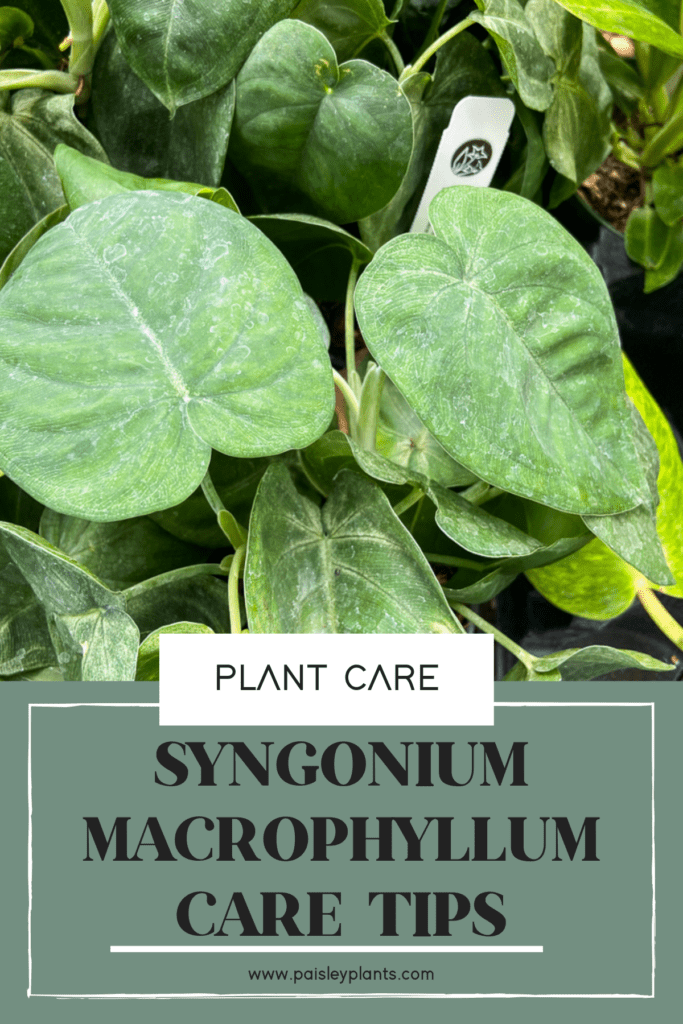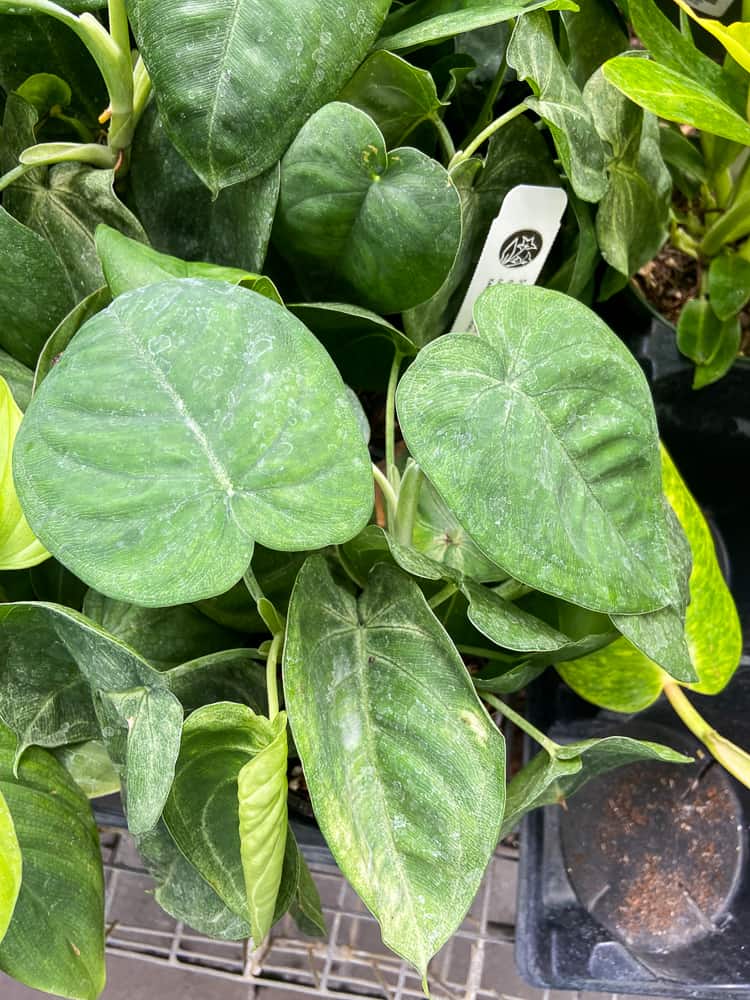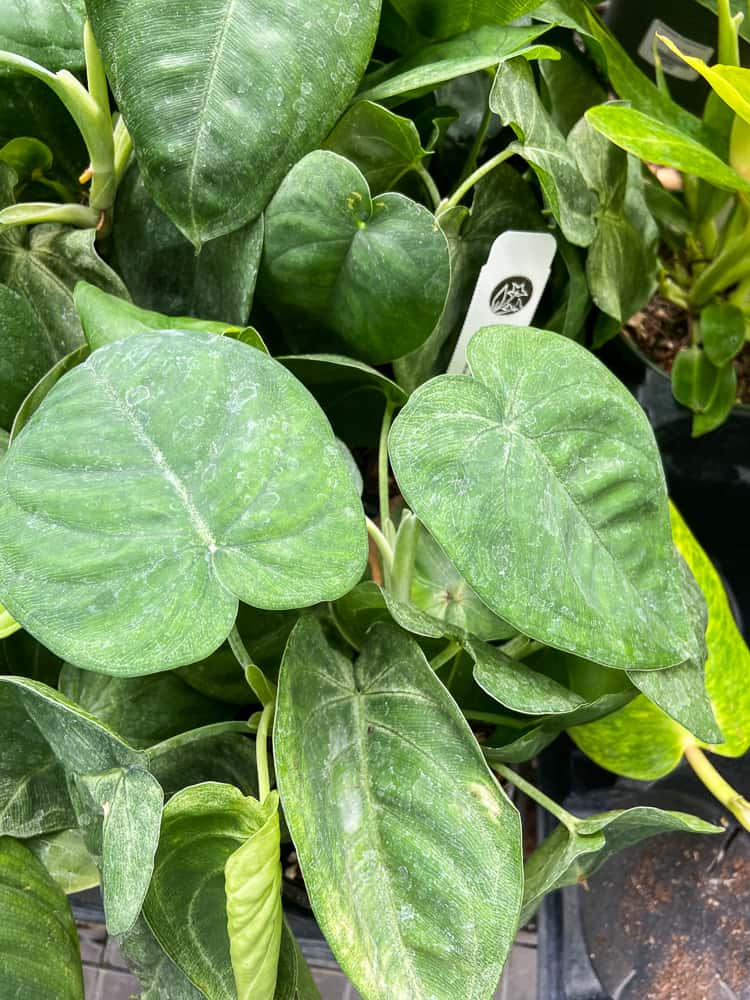The syngonium ice frost may be one of the rarer members of the syngonium genus, but rest assured taking care of this beautiful plant couldn’t be easier! Read on for this ultimate care guide to the syngonium ice frost.
Table of Contents
Background
The Syngonium macrophyllum, or otherwise commonly known as the syngonium ice frost is a unique plant that originates from Central and South America.
Other common names for the syngonium ice frost include the “arrowhead plant” (a common umbrella term for syngoniums) and the “frosted heart.” These names are a reference to the pointed-oval shape of the syngonium’s leaves.
The syngonium ice frost in particular is identifiable by its heart-shaped leaves with a light, frosty shade of green. This plant is a climbing variety and can grow to be at least 3 feet long at full maturity.
Unfortunately, if you have young children or animals around the house, you will want to be cautious with owning an ice frost. Just like all syngoniums, the ice frost is toxic to both humans and animals. Ingestion of this plant can cause severe irritation to the digestive tract.
Syngonium Macrophyllum Care

This post includes affiliate links.
Sun & Light
Ice frost plants enjoy bright, indirect light. However, it is important to make sure your plants are not subjected to direct sunlight.
Direct sun can cause severe leaf burning on your plant. If you notice crispy edges around the leaves of your syngonium macrophyllum, this can be a sign of direct sun exposure.
Soil Type
The syngonium prefers a soil that is well-draining, airy, and slightly acidic. Standard indoor potting mix is perfectly acceptable to use with this plant.
However, we recommend improving upon your soil by including perlite and coco coir. Your soil will be well-draining, but still hold in just enough moisture to make your plant feel right at home.
Water
The soil of your syngonium plant should be kept consistently moist, especially during the active growing season. We recommend waiting until the top layer of soil has dried up before giving your plant water.
In the wintertime, your plant will require less water and can survive without water for a longer period of time. If your plant is wilting, this is a telltale sign of dehydration.

Fertilizer
Your syngonium macrophyllum will benefit immensely from a regular fertilizer routine to encourage fuller, bushier growth.
Select a balanced liquid fertilizer and apply it to your plant once a month through the spring, summer, and fall. Stop fertilizing your plant altogether in the wintertime.
Temperature & Humidity
As a plant native to South and Central America, the syngonium ice frost has a preference for warm, humid climates. Despite its tropical origins, it is easy to maintain an optimal air climate for your syngonium at home.
Your syngonium will prefer a temperature of at least 60° F. Avoid placing this plant in any location where the temps can dip below 60; areas such as near an air conditioning vent are a no-go.
In addition, a humidity level of at least 50% is ideal for these plants. Luckily, most households’ humidity level is in the optimal range. If your plant is not happy, they’ll let you know; crunchy, dry leaves are a common symptom of dryness in a plant.
Pruning Your Plant
Pruning is a necessary step to encouraging bushy growth in your plant as well as maintaining height and appearance.
Whenever necessary, always prune any foliage that has died, became damaged/diseased. Removing these parts will help your plant redirect its energy towards developing new, healthy growth as opposed to wasting energy sustaining dying foliage.
As a climbing plant, the syngonium ice frost has the potential to become quite large (at least 3 feet in length). Some gardeners prefer to trim their climbing plants down to a more manageable, bush-like size and shape.
We highly recommend always sterilizing your cutting tools before pruning your plant. A quick wipe with rubbing alcohol will effectively sterilize your plant, making it safe to prune.

Choosing a Container & Repotting
When selecting a container to house your ice frost in, it is absolutely necessary to select a plant pot that has multiple drainage holes. Drainage holes help expel unnecessary moisture from your plant pot to keep your plant’s soil moist, but not waterlogged.
Expect to repot your plant around every 2 years. If you start to notice roots beginning to grow from the drainage holes or the top of the planter, then you should immediately repot your plant to a new container.
When repotting your plant, always be sure to gradually size up to a new pot. It’s actually counterproductive to your plant’s development to transfer it into a significantly larger pot, as this can cause transplant shock to your syngonium.
How to Propagate Syngonium Macrophyllum Ice Frost
The easiest method of propagating a syngonium ice frost is through stem cuttings. Follow these simple steps to multiply your syngonium.
- Your syngonium plant must be mature before you propagate; check to see if your plant grows aerial roots and has exposed growth points.
- Using a sterile pair of scissors, cut off a segment of the plant just below a leaf node.
- Fill a small jar with water and submerge the cut-end of the stem into the water. However, you must make sure the leaves are exposed to the air, as this air circulation will help increase the rate of propagation.
- Keep the jar in a location with bright, indirect light. Be sure to replenish the water in the jar every week in order to reduce the risk of bacteria build up.
- It takes about a month before you begin to notice roots forming from the cutting. Wait until the roots are at least 1 inch in length before transplanting the cutting into a plant pot with well-draining soil.
Common Pests
Most syngoniums tend to be resistant to most pests, but of course incidents happen and it is always good to be prepared for the worst. Examples of pests that may try to attack your syngonium include common household pests such as aphids, spider mites, scale, and mealybugs.
It should be noted that pests often target unhealthy plants. Your best prevention method for these insects is to take care of your plant diligently.
If you do encounter pests attacking your plant, we recommend spritzing neem oil onto the affected areas of the plant. Neem oil is a powerful horticultural oil that gardeners swear by. It is organic and can swiftly eradicate your pest problem in a few rounds of spray.
Common Diseases
Syngonium plants are highly susceptible to root rot. Root rot is caused by an excess of soil moisture combined with insufficient drainage. This results in the trapped moisture harboring bacteria, which kills the roots of the plant. Common signs of root rot include wilting, dying foliage and leaf discoloration.
If you are suspicious that your plant has root rot, do not hesitate to act on it. Root rot can be devastating, but when it is handled early, your plant can be saved. Follow these steps to learn more:
- Remove the plant from its pot and inspect the root system. Rotten roots are soft in texture and have turned near-black from the rot.
- Using a sterile pair of shears, cut away at all signs of rot.
- When all rot has been cleared, repot your plant in a sterile plant pot that has multiple drainage holes. Fill the planter with a soil that is well-draining.
- For the next couple of weeks, keep the soil lightly moist; this helps mitigate the effects of transplant shock.
FAQ
Yes, the syngonium ice frost is considered one of the rarer arrowhead plants and is seldom found at your typical big-name plant nurseries. However, there are many accredited online retailers who sell syngonium ice frosts. In addition, this plant can be easily propagated with stem cuttings once it is mature enough to propagate. If you find one ice frost, then you can propagate it into making several ice frosts.
Syngonium ice frost are trailing plants, and they are capable of climbing with a moss pole. However, the choice of letting your syngonium climb is entirely up to you. Keep in mind that a moss pole will help encourage your plant to grow larger than average. Some owners of the ice frost also grow their plant in a hanging basket to allow the branches to freely drape.
In Conclusion
If you have the luck of finding a syngonium ice frost, do not hesitate to buy it! Syngonium ice frosts are gorgeous plants that brighten your home without too much of a commitment.
Want to learn about more plants? Head to one of these!

